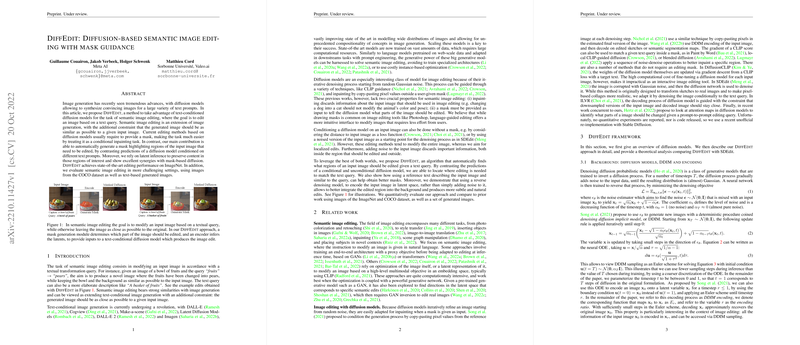Exploring DiffEdit: Diffusion-Based Semantic Image Editing
The research paper "DiffEdit: Diffusion-based semantic image editing with mask guidance" presents an innovative approach to semantic image editing utilizing diffusion models. The work leverages the probabilistic capabilities of diffusion models to handle image editing tasks with text-based prompts, offering automated solutions for generating region masks within images.
DiffEdit's primary function is to facilitate semantic image editing by identifying the specific regions of an image that require modification, guided entirely by textual input. The task, as outlined in the paper, incorporates modifications in images, ensuring that they remain as similar as possible to the original inputs while reflecting the changes articulated through text prompts. This balancing act of maintaining image fidelity while achieving semantic alterations distinguishes DiffEdit from other inpainting methods that rely on predefined masks to guide image edits.
The methodology of DiffEdit consists of three crucial steps:
- Mask Generation: Unlike conventional techniques that require user-supplied masks, DiffEdit automatically generates mask regions by contrasting noise predictions derived from diffusion models under different textual conditions. This process identifies image areas pertinent to the requested semantic changes.
- Encoding: Before editing, DiffEdit encodes the input image to a latent space representation. This encoding step is performed unconditionally to preserve the image's inherent properties during the editing phase.
- Mask-Guided Decoding: In this step, the encoded image is decoded with the adjustments dictated by the text prompt. The mask generated in the first step restricts edits to the identified regions, thereby maintaining the image's overall integrity.
The paper presents extensive experimental analyses, evaluating DiffEdit against other notable methods such as SDEdit and ILVR across multiple datasets including ImageNet, COCO, and images generated by Imagen. Key metrics used for these evaluations include LPIPS, CSFID, and FID, which measure perceptual distances and class-conditional realism, respectively. These experiments demonstrate that DiffEdit achieves superior trade-off curves, indicating an effective balance between maintaining image similarity and achieving coherent semantic edits.
The theoretical exploration in the paper, particularly the proposition concerning the DDIM encoder, underlines why DiffEdit outperforms noise-based alternatives such as SDEdit. The authors provide bounds that show how DDIM encoding yields closer statistical expectations between input and output images — a critical feature for semantic editing tasks.
Practical implications of DiffEdit extend across numerous applications where intuitive, text-driven image manipulation is necessary without extensive user training or manual interaction with image details. The implications of this research also stretch toward advancing our understanding of diffusion processes and their application in conditional generation tasks, potentially influencing AI developments in generative adversarial networks (GANs) and similar models.
In summary, the DiffEdit framework proposes a sophisticated melding of diffusion model capabilities with semantic editing requirements, positioning itself as a state-of-the-art solution in the field of text-based image alterations. This paper not only advances the technical boundary of semantic image editing but also sets a precedent for future research to refine and extend diffusion model applications in various AI-driven tasks.
